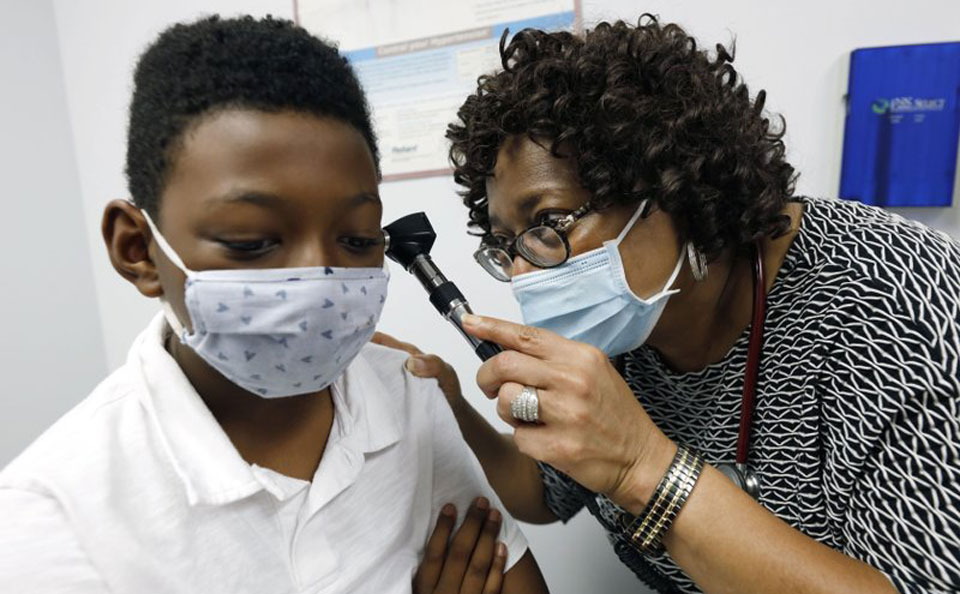
A health care worker in Baltimore had to be quarantined for two weeks in an empty downtown hotel, says Lisa Cooper, a public health specialist at Johns Hopkins University there. She had been exposed to the coronavirus on the job, and she lived in a multigenerational household.
“She had to be housed in the hotel to prevent infection of the rest of the family,” Cooper adds.
That worker’s not alone, not just in majority-minority Baltimore, but in the nation’s four biggest cities, a new report and its analysts said in a Sept. 16 Zoom teleconference.
The Impact Of The Coronavirus On Households In Major U.S. Cities, from the health-care oriented Robert Wood Johnson Foundation, Harvard University, and National Public Radio, quantifies common knowledge about the impact of the pandemic, and not just in health care.
The coronavirus is not an equal opportunity menace, the survey of 3,454 adults in the four cities–New York, Los Angeles, Chicago, and Houston–report. While the virus sweeps the entire country, households of color get hit harder, in health, finances, jobs, and educating their kids, it adds.
Those statements have been uttered time and time again as the virus has plowed its way through the U.S. As of 2 p.m. Eastern Time on Sept. 16, 6.61 million people have tested positive for the virus since the pandemic was officially declared March 13. And 196,349 have died, according to one of the most authoritative sources, Johns Hopkins University.
But the death and illness toll is only part of the coronavirus story. The numbers not only outline the current disaster, but expose the extent of the systemic problems afflicting U.S. people of color, including income inequality, lack of household wealth, unequal health care, and lagging educational opportunity.
The big two, says co-author Robert Blendon of Harvard, are in health care and money. In plain English, the virus and resulting unemployment caused by efforts to combat it have wiped out the finances of 72% of Latinx people, 60% of Blacks, and 55% of Native Americans surveyed in the nation’s four largest cities, New York, Los Angeles, Chicago, and Houston.
“The three groups are trying to cope with unbelievable problems. They’re just being ravaged,” he added. “Four in 10 of those households report their savings are gone. If anything else happens next week, there’s no pool of savings to draw on.”
That’s not to say other groups have been unaffected. Surveyors found 37% of Asian households and 36% of white households got hit financially too.
And in health care, “If someone says to you ‘We screened your sister’” for the coronavirus “and the two of you can’t go out of the house for two weeks,” it not only hurts their health but robs that family of a paycheck and in many cases, their breadwinners’ jobs, Blendon noted.
Job loss, furloughs, and wage cuts due to the coronavirus hit half of households surveyors contacted in New York City, the report says, for example. They hit 50% in L.A. and Chicago and 63% in Houston.
Of that half of New York families who suffered job and income loss, 73% reported serious financial problems, including 73% of Latinx households, 62% of Black households, and 65% of all households whose income was less than $100,000 the year before. Percentages were similar in Chicago and L.A. and higher in Houston: 81% among Blacks and 77% among Latinx households.
And federal aid hasn’t been targeted enough to the worst-off people, Blendon and the other speakers said. “We can’t address what we don’t measure,” commented Dr. Avenel Joseph of the Johnson Foundation,
“The national response has failed too many families. We want to believe we’re all in this together, but really Black, Latino and Indigenous families are at the highest risk and also face the biggest financial challenge,” said Joseph.
That’s because “there are glaring structural inequalities” in health, education, finances, housing, and more “and they’re both deeply embedded in our society and not filled up by temporary dollars” from the federal government.
Once we figure out who gets hit the worst, “we can target resources to those in need,” Joseph pointed out. But those in most need should have a seat at the table, too, besides the politicians and the policymakers, Joseph contended.
Though the report did not say so, those federal aid dollars have also stopped flowing, except to businesses. Eligibility for weekly $600 federal unemployment compensation checks, which Congress instituted under the $2 trillion Cares Act in mid-March—and then only after Senate Democrats’ pressure forced Majority Leader Mitch McConnell, R-Ky., to yield—have run out.
In some states, notably but not exclusively Florida, the jobless still haven’t gotten their checks. And while McConnell and GOP President Donald Trump want to temporarily replace the $600 with $300, obtained from a pot of money that will run out next month, 20 of the 53 Senate Republicans want to give the jobless nothing at all.
But targeting the worst-off victims of the coronavirus pandemic raises another question, the panelists said: Trust. Public opinion surveys, though not discussed in the report, show massive distrust of GOP President Donald Trump’s handling of the coronavirus crisis—a distrust that has seeped down to skepticism about other government statements about the pandemic.
And, as the speakers pointed out, there are millions of people who flatly disbelieve in the pandemic’s severity and seriousness. They either battle or refuse to undertake anti-coronavirus measures, such as mask-wearing in public, social distancing, no crowds, no eating inside restaurants, going to arenas or movies, undergoing testing and quarantines, or constant handwashing.
Though the panel participants did not say so, Trump’s public refusal to take the pandemic seriously—even though he knew its massive danger weeks before the official declaration–and his constant challenges to social distancing, mask-wearing, and school closures, all play into that mindset.
The panel discussing the report admitted “you can’t force people” to wear masks or practice social distancing. But if you can find people they trust, such as clergy, to convince them to have open minds to facts about the coronavirus, you may be able to turn them around.
The 106-page report, with breakdowns by city for each category—finances, health, housing, education, and hunger among them—is here. A subsequent report will have nationwide survey figures broken down by race.










